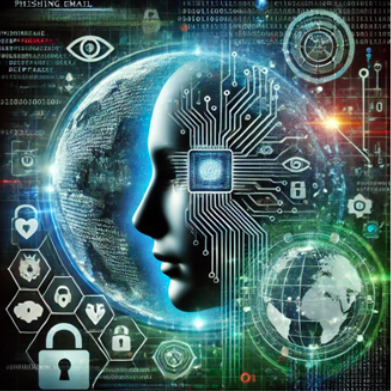
The Role of Artificial Intelligence in Modern Cyber Defence: Friend or Foe?
The integration of Artificial Intelligence (AI) in cybersecurity has transformed the way organizations detect, prevent, and respond to cyber threats. As cyberattacks become more sophisticated, traditional security measures are proving insufficient. AI offers the potential to not only enhance threat detection but also automate responses, making it a double-edged sword in the cybersecurity landscape.
The Rise of AI in Cybersecurity
Artificial Intelligence (AI) is significantly transforming cybersecurity by enhancing threat detection and minimizing false positives. AI-driven systems can analyze large datasets in real-time, spotting patterns that indicate potential cyber threats or unusual user behavior. By continuously monitoring network traffic, AI can detect anomalies that might suggest malicious activity, enabling faster and more precise responses from security teams.
AI's ability to reduce false positives is a notable advantage over traditional methods, which often overwhelm analysts with irrelevant alerts. By accurately filtering out benign activities, AI allows cybersecurity professionals to focus on genuine threats. This improves overall efficiency and speeds up the response to critical incidents.
The market for AI-powered cybersecurity tools reflects this trend, with predictions showing growth from $15 billion in 2021 to $135 billion by 2030. The widespread adoption of AI in cybersecurity also enhances other functions like phishing detection, social engineering simulations, and rapid analysis of incident data, helping organizations identify vulnerabilities before attackers can exploit them. This proactive approach not only enhances defense capabilities but also reduces potential costs associated with security breaches.
AI in the Wrong Hands: Risks and Exploits
While AI has become a powerful tool in cybersecurity, it also presents significant risks when misused by malicious actors. Cybercriminals are increasingly harnessing AI's capabilities to enhance their attacks and exploit vulnerabilities in novel ways:
-
Automated Social Engineering: AI enables attackers to create highly convincing phishing emails and other fraudulent messages. By automating the process, cybercriminals can launch large-scale, personalized social engineering schemes that trick individuals into revealing sensitive information, making these attacks more effective and harder to detect.
-
Enhanced Password Hacking: AI-powered algorithms can rapidly guess passwords with higher accuracy. Machine learning models can analyze common password patterns and improve cracking techniques, allowing hackers to bypass traditional security measures more efficiently.
-
Deepfakes for Fraud and Manipulation: Deepfake technology, driven by AI, can generate realistic fake audio or video content. Cybercriminals use deepfakes to impersonate executives or employees in scams, leading to fraudulent transactions or extortion attempts. The convincing nature of deepfakes poses a significant challenge for identifying authentic communications.
-
Data Poisoning Attacks: In data poisoning, attackers manipulate the training data of AI systems to influence their decision-making. By feeding AI algorithms deceptive information, hackers can compromise the system's accuracy, leading to incorrect threat assessments or decisions, which can have severe security implications.
These tactics show how AI can be weaponized to enhance the sophistication and scale of cyberattacks. As AI technology continues to evolve, cybersecurity professionals must stay vigilant, continuously adapting their defense strategies to counter these emerging threats.
Future of AI and Cybersecurity
The future of AI in cybersecurity is promising, with immense potential for growth and innovative applications. As the technology advances, we can expect to see AI integrated with other cutting-edge technologies, such as blockchain and the Internet of Things (IoT). Blockchain's decentralized and immutable nature can enhance data integrity, while AI can analyze blockchain transactions in real-time to detect fraudulent activity. In IoT environments, AI can monitor vast networks of connected devices, identifying vulnerabilities and responding to threats swiftly, making these systems more secure.
With AI's growing importance in cybersecurity, there is a rising demand for skilled professionals who can effectively deploy and manage AI-based solutions. These experts must possess a deep understanding of both cybersecurity principles and AI technologies to harness AI's full potential for threat detection, anomaly identification, and automated response.
Despite initial concerns that AI would replace traditional jobs, it has instead augmented business processes, enabling cybersecurity teams to operate more efficiently. AI-driven systems complement human expertise by automating routine tasks and providing advanced threat insights, allowing professionals to focus on strategic decision-making and complex problem-solving.
While AI offers significant advantages, such as real-time detection of novel threats and cost reduction through automation, it also poses challenges, particularly in terms of ethical considerations and malicious use. Organizations must prioritize ethical AI practices, ensuring transparency, fairness, and robust security measures to prevent misuse. As cybercriminals adopt AI tools for sophisticated attacks, the race between defenders and attackers to leverage AI effectively will shape the future cyber threat landscape.
In conclusion, the continued integration of AI in cybersecurity, combined with skilled human oversight, promises to revolutionize defense strategies, making them more adaptive, proactive, and resilient against evolving cyber threats.
References
-
‘How AI is Revolutionising Cybersecurity’, [https://www.pentestpeople.com/blog-posts/how-ai-is-revolutionising-cybersecurity].
-
‘AI and Cybersecurity a New Era’, [https://www.morganstanley.com/articles/ai-cybersecurity-new-era].
-
‘AI in Cyber Security: Risks of AI’, [https://www.malwarebytes.com/cybersecurity/basics/risks-of-ai-in-cyber-security].
-
‘Artificial Intelligence and Cybersecurity: The Future is Now’, [https://www.eccu.edu/blog/cybersecurity/artificial-intelligence-the-future-of-cybersecurity/]
-
‘The Impact of AI on Cybersecurity: Predictions for the Future’, [https://www.upguard.com/blog/the-impact-of-ai-on-cybersecurity]
Edited By: Windhya Rankothge, PhD, https://www.unb.ca/cic/
Related Blogs: https://cyberdailyreport.com/blog/76 , https://cyberdailyreport.com/blog/43